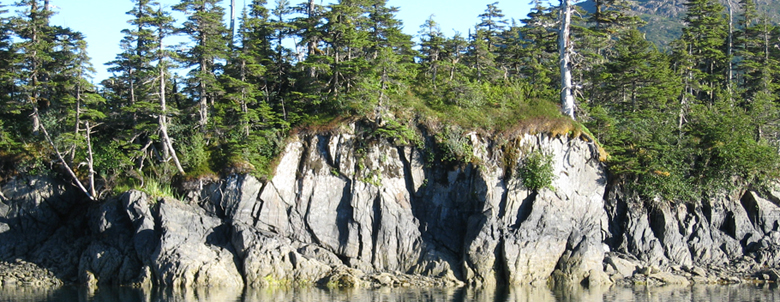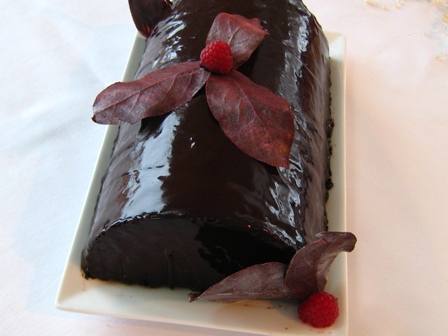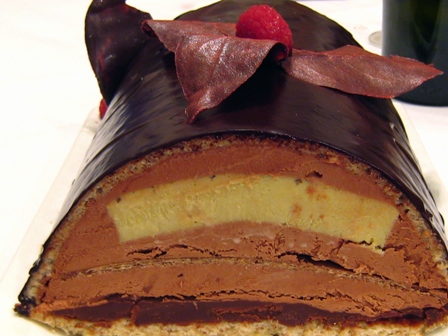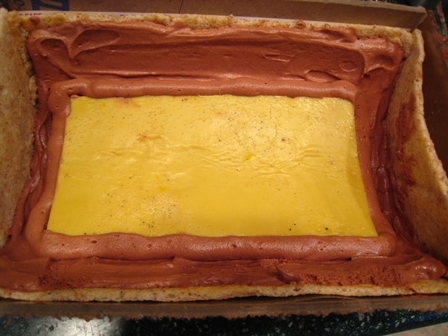DARING BAKERS DECEMBER CHALLENGE
As you all might know by now, I am a participating member of Daring Bakers. Each month we are given a baking challenge, and sometime during the month we complete the challenge, then post about it on the specified date at the end of the month. Before this month, I had participated in 4 challenges (I think that’s right, unless I am forgetting about one) and some have been much more challenging than the others. This month’s challenge rates up there with the most challenging. Before I tell you about the challenge, I’ll say that when I printed off all of the instructions and recipes to begin with, it was 18 pages long! Okay, the Challenge this month is…
A French Yule Log!!!
This month’s challenge is brought to us by the adventurous Hilda from Saffron and Blueberry and Marion from Il en Faut Peu Pour Etre Heureux. They have chosen a French Yule Log by Flore from Florilege Gourmand.
A little background about Yule logs: In France you can buy two kinds of Yule log, either the Genoise and Buttercream type that the Daring Bakers made last December, or what is more commonly purchased which is a frozen Yule Log very reminiscent of an ice cream cake, only often it’s not made of ice cream but rather frozen mousse of some sort. In French this is called an entremets which is sometimes loosely translated in English as simply a cream dessert. This also means that this recipe is not holiday-specific, it is also just a scrumptious dessert recipe.
The French Yule Log recipe contained 6 elements, all of which had to be included in our logs:
1) Dacquoise Biscuit
2) Mousse
3) Ganache Insert
4) Praline (Crisp) Insert
5) Creme Brulee Insert
6) Icing
Recipes were given for each element, along with a few variations. But you were allowed to make changes to the recipes and flavor the elements as you chose.
This is the inside of my Yule Log. My elements were an Almond Dacquoise, a Dark Chocolate Mousse flavored with raspberry puree, a Dark Chocolate Ganache Insert, a Praline Feuillete (Crisp) Insert, a Vanilla Creme Brulee Insert flavored with Chambord, and a Dark Chocolate Icing.
Most of us do not have a Yule Log mold. Some Daring Bakers instead chose to make theirs in a round cake pan, or many used a loaf pan. I decided to make a mold for mine. I took a thick cardboard mailing tube and had my husband slice it in half. I cut cardboard to fit and covered the ends. I then lined it in a plastic acetate (transparency). Nothing gets baked in the mold, just frozen, so it worked fine. Here’s a photo.
Here’s a photo as the log was being assembled. The dacquoise biscuit is lining the mold, then the first layer of mousse was piped in, then the creme brulee (which was baked, cooled, then frozen) was layered in. Another layer of mousse was beginning to be piped in.
Then I finished piping in the second layer of mousse, added the Praline Crisp, piped a third layer of mousse, then piped the Dark Chocolate Ganache layer on. Then I topped it off with another Dacquoise Biscuit. This was then frozen overnight, and the next morning I made the Dark Chocolate Icing and poured it over the cake. Back into the freezer. I decorated mine by making some chocolate leaves which I brushed with a pearlized powder food coloring.
I didn’t have trouble making any of the elements, but it was time consuming. The day I made the components and assembled it, I think I spent about 6 hours. So it was a challenge, but a very tasty one. I prefered the Yule Log when it was almost thawed as opposed to being frozen.
Listed below is the basic recipe, without all of the variations listed.
FRENCH YULE LOG OR ENTREMETS RECIPE by Flore of Florilège Gourmand
Element #1 Dacquoise Biscuit (Almond Cake)
Note: You can use the Dacquoise for the bottom of your Yule Log only, or as bottom and top layers, or if using a Yule log mold (half-pipe) to line your entire mold with the biscuit. Take care to spread the Dacquoise accordingly. Try to bake the Dacquoise the same day you assemble the log to keep it as moist as possible.
Ingredients:
2.8 oz (3/4cup + 1Tbsp / 80g) almond meal
1.75 oz (1/2 cup / 50g) confectioner’s sugar
2Tbsp (15g) all-purpose flour
3.5oz (100g / ~100ml) about 3 medium egg whites
1.75 oz (4 Tbsp / 50g) granulated sugar
1. Finely mix the almond meal and the confectioner’s sugar. (If you have a mixer, you can use it by pulsing the ingredients together for no longer than 30 seconds).
2. Sift the flour into the mix.
3. Beat the eggs whites, gradually adding the granulated sugar until stiff.
4. Pour the almond meal mixture into the egg whites and blend delicately with a spatula.
5. Grease a piece of parchment paper and line your baking pan with it.
6. Spread the batter on a piece of parchment paper to an area slightly larger than your desired shape (circle, long strip etc…) and to a height of 1/3 inches (8mm).
7. Bake at 350°F (180°C) for approximately 15 minutes (depends on your oven), until golden.
8. Let cool and cut to the desired shape.
Element #2 Dark Chocolate Mousse
Note: You will see that a Pate a Bombe is mentioned in this recipe. A Pate a Bombe is a term used for egg yolks beaten with a sugar syrup, then aerated. It is the base used for many mousse and buttercream recipes. It makes mousses and buttercreams more stable, particularly if they are to be frozen, so that they do not melt as quickly or collapse under the weight of heavier items such as the crème brulee insert.
Ingredients:
2.5 sheets gelatin or 5g / 1 + 1/4 tsp powdered gelatin
1.5 oz (3 Tbsp / 40g) granulated sugar
1 ½ tsp (10g) glucose or thick corn syrup
0.5 oz (15g) water
50g egg yolks (about 3 medium)
6.2 oz (175g) dark chocolate, coarsely chopped
1.5 cups (350g) heavy cream (35% fat content)
1. Soften the gelatin in cold water. (If using powdered gelatin, follow the directions on the package.)
2. Make a Pate a Bombe: Beat the egg yolks until very light in colour (approximately 5 minutes until almost white).
2a. Cook the sugar, glucose syrup and water on medium heat for approximately 3 minutes (if you have a candy thermometer, the mixture should reach 244°F (118°C). If you do not have a candy thermometer, test the sugar temperature by dipping the tip of a knife into the syrup then into a bowl of ice water, if it forms a soft ball in the water then you have reached the correct temperature.
2b. Add the sugar syrup to the beaten yolks carefully by pouring it into the mixture in a thin stream while continuing to beat the yolks. You can do this by hand but it’s easier to do this with an electric mixer.
2c. Continue beating until cool (approximately 5 minutes). The batter should become thick and foamy.
3. In a double boiler or equivalent, heat 2 tablespoons (30g) of cream to boiling. Add the chopped chocolate and stir until melted and smooth.
4. Whip the remainder of the cream until stiff.
5. Pour the melted chocolate over the softened gelatin, mixing well. Let the gelatin and chocolate cool slightly and then stir in ½ cup (100g) of WHIPPED cream to temper. Add the Pate a Bombe.
6. Add in the rest of the WHIPPED cream (220g) mixing gently with a spatula.
Element #3 Dark Chocolate Ganache Insert
Note: Because the ganache hardens as it cools, you should make it right before you intend to use it to facilitate piping it onto the log during assembly. Please be careful when caramelizing the sugar and then adding the cream. It may splatter and boil.
Ingredients:
1.75 oz (4 Tbsp / 50g) granulated sugar
4.5oz (2/3 cup – 1 Tbsp/ 135g) heavy cream (35% fat content)
5 oz (135g) dark chocolate, finely chopped
3Tbsp + 1/2tsp (45g) unsalted butter softened
1. Make a caramel: Using the dry method, melt the sugar by spreading it in an even layer in a small saucepan with high sides. Heat over medium-high heat, watching it carefully as the sugar begins to melt. Never stir the mixture. As the sugar starts to melt, swirl the pan occasionally to allow the sugar to melt evenly. Cook to dark amber color (for most of you that means darker than last month’s challenge).
2. While the sugar is melting, heat the cream until boiling. Pour cream into the caramel and stir thoroughly. Be very careful as it may splatter and boil.
3. Pour the hot caramel-milk mixture over the dark chocolate. Wait 30 seconds and stir until smooth.
4. Add the softened butter and whip hard and fast (if you have a plunging mixer use it). The chocolate should be smooth and shiny.
Element #4 Praline Feuillete (Crisp) Insert
Note: Feuillete means layered (as in with leaves) so a Praline Feuillete is a Praline version of a delicate crisp. There are non-praline variations below. The crunch in this crisp comes from an ingredient which is called gavottes in French. Gavottes are lace-thin crepes. To our knowledge they are not available outside of France, so you have the option of making your own using the recipe below or you can simply substitute rice krispies or corn flakes or Special K for them. Special note: If you use one of the substitutes for the gavottes, you should halve the quantity stated, as in use 1oz of any of these cereals instead of 2.1oz.
If you want to make your own praline, please refer back to the Daring Baker Challenge Recipe from July 2008.
To make 2.1oz / 60g of gavottes (lace crepes – recipe by Ferich Mounia):
1/3 cup (80ml) whole milk
2/3 Tbsp (8g) unsalted butter
1/3 cup – 2tsp (35g) all-purpose flour
1 Tbsp / 0.5 oz (15g) beaten egg
1 tsp (3.5g) granulated sugar
½ tsp vegetable oil
1. Heat the milk and butter together until butter is completely melted. Remove from the heat.
2. Sift flour into milk-butter mixture while beating, add egg and granulated sugar. Make sure there are no lumps.
3. Grease a baking sheet and spread batter thinly over it.
4. Bake at 430°F (220°C) for a few minutes until the crepe is golden and crispy. Let cool.
Ingredients for the Praline Feuillete:
3.5 oz (100g) milk chocolate
1 2/3 Tbsp (25g) butter
2 Tbsp (1 oz / 30g) praline
2.1oz (60g) lace crepes(gavottes) or rice krispies or corn flakes or Special K
1. Melt the chocolate and butter in a double boiler.
2. Add the praline and the coarsely crushed lace crepes. Mix quickly to thoroughly coat with the chocolate.
3. Spread between two sheets of wax paper to a size slightly larger than your desired shape. Refrigerate until hard.
Element #5 Vanilla Crème Brulée Insert
Ingredients:
1/2 cup (115g) heavy cream (35% fat content)
½ cup (115g) whole milk
4 medium-sized (72g) egg yolks
0.75 oz (2 Tbsp / 25g) granulated sugar
1 vanilla bean
1. Heat the milk, cream, and scraped vanilla bean to just boiling. Remove from the stove and let the vanilla infuse for about 1 hour.
2. Whisk together the sugar and egg yolks (but do not beat until white).
3. Pour the vanilla-infused milk over the sugar/yolk mixture. Mix well.
4. Wipe with a very wet cloth and then cover your baking mold (whatever shape is going to fit on the inside of your Yule log/cake) with parchment paper. Pour the cream into the mold and bake at 210°F (100°C) for about 1 hour or until firm on the edges and slightly wobbly in the center. (Note: I had to turn up the temp and cook for longer than stated.)
5. Let cool and put in the freezer for at least 1 hour to firm up and facilitate the final assembly.
Element #6 Dark Chocolate Icing
Note: Because the icing gelifies quickly, you should make it at the last minute.
For other gelatin equivalencies or gelatin to agar-agar equivalencies, look at the notes for the mousse component.
Ingredients:
4g / ½ Tbsp powdered gelatin or 2 sheets gelatin
¼ cup (60g) heavy cream (35 % fat content)
2.1 oz (5 Tbsp / 60g) granulated sugar
¼ cup (50g) water
1/3 cup (30g) unsweetened cocoa powder
1. Soften the gelatin in cold water for 15 minutes.
2. Boil the rest of the ingredients and cook an additional 3 minutes after boiling.
3. Add gelatin to the chocolate mixture. Mix well.
4. Let cool while checking the texture regularly. As soon as the mixture is smooth and coats a spoon well (it is starting to gelify), use immediately.
How To Assemble your French Yule Log
Depending on whether your mold is going to hold the assembly upside down until you unmold it or right side up, this order will be different.
THIS IS FOR UNMOLDING FROM UPSIDE DOWN TO RIGHT SIDE UP.
You will want to tap your mold gently on the countertop after each time you pipe mousse in to get rid of any air bubbles.
1) Line your mold or pan, whatever its shape, with rhodoid (clear hard plastic, I usually use transparencies cut to the desired shape, it’s easier to find than cellulose acetate which is what rhodoid translates to in English) OR plastic film. Rhodoid will give you a smoother shape but you may have a hard time using it depending on the kind of mold you’re using.
You have two choices for Step 2, you can either have Dacquoise on the top and bottom of your log as in version A or you can have Dacquoise simply on the bottom of your log as in version B:
2A) Cut the Dacquoise into a shape fitting your mold and set it in there. If you are using an actual Yule mold which is in the shape of a half-pipe, you want the Dacquoise to cover the entire half-pipe portion of the mold.
3A) Pipe one third of the Mousse component on the Dacquoise.
4A) Take the Creme Brulee Insert out of the freezer at the last minute and set on top of the mousse. Press down gently to slightly ensconce it in the mousse.
5A) Pipe second third of the Mousse component around and on top of the Creme Brulee Insert.
6A) Cut the Praline/Crisp Insert to a size slightly smaller than your mold so that it can be surrounded by mousse. Lay it on top of the mousse you just piped into the mold.
7A) Pipe the last third of the Mousse component on top of the Praline Insert.
8A) Freeze for a few hours to set. Take out of the freezer.
9A) Pipe the Ganache Insert onto the frozen mousse leaving a slight eidge so that ganache doesn’t seep out when you set the Dacquoise on top.
10A) Close with the last strip of Dacquoise.
Freeze until the next day.
OR
2B) Pipe one third of the Mousse component into the mold.
3B) Take the Creme Brulee Insert out of the freezer at the last minute and set on top of the mousse. Press down gently to slightly ensconce it in the mousse.
4B) Pipe second third of the Mousse component around and on top of the Creme Brulee Insert.
5B) Cut the Praline/Crisp Insert to a size slightly smaller than your mold so that it can be surrounded by mousse. Lay it on top of the mousse you just piped into the mold.
6B) Pipe the last third of the Mousse component on top of the Praline Insert.
7B) Freeze for a few hours to set. Take out of the freezer.
8B) Pipe the Ganache Insert onto the frozen mousse leaving a slight edge so that ganache doesn’t seep out when you set the Dacquoise on top.
9B) Close with the Dacquoise.
Freeze until the next day.
THE NEXT DAY…
Unmold the cake/log/whatever and set on a wire rack over a shallow pan.
Cover the cake with the icing.
Let set. Return to the freezer.
You may decorate your cake however you wish. The decorations can be set in the icing after it sets but before you return the cake to the freezer or you may attach them on top using extra ganache or leftover mousse, etc…
Transfer to the refrigerator no longer than ½ hour before serving as it may start to melt quickly depending on the elements you chose.






Simple elegance. Beautiful!
Your yule log looks fantastic – great job at the decoration. Also wish you a happy new year.
Dear lord – what a challenge! Your yule log looks great – you should be impressed!
Looks fantastic! Great job!
Very creative mold! It turned out great! Raspberry sounds tasty in this.
You did an amazing job. Your ‘entrement’, aka Yule Log, looks great!
A very pretty log! Well done!
Cheers,
Rosa
Beautiful yule log. Great job! I can’t remember ever reading a more complicated recipe than this one.
I’m floored!
What a perfect outcome!
I love the decorations… so dainty and delicate! WOW!
Wow, what a jewel! Bet it tastes divine.
Awesome! Your log is spectacular!!
That is absolutely amazing. I hope it tasted as fabulous as it looks!
Absolutely beautiful! Major kudos to you for doing such a daring feat so well.
This is beautifull, I really like your homemade mold !
Very nice – and good work on the mold, creativity in the kitchen!
You did a marvelous job with the buche de noel! It’s so pretty. By the way, I consider myself an Alaskan, thought I am currently living down south (New Mexico). 25 of my years were spent in Alaska, so it’s definitely the place I call “home.”
Very well done on your log!
What a great job you did. Love the step-by-step photos. The final result is really worth it. That icing is so dark and shiny and makes the log look like it should be eaten NOW!!!! Happy NY to you and your family and friends.
Wow, you were clever with the tube mold! You completed a real challenge and made a beautifule creations!!